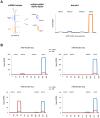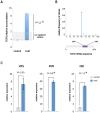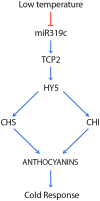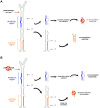Alternative processing of its precursor is related to miR319 decreasing in melon plants exposed to cold
- PMID: 30341377
- PMCID: PMC6195573
- DOI: 10.1038/s41598-018-34012-7
Alternative processing of its precursor is related to miR319 decreasing in melon plants exposed to cold
Erratum in
-
Author Correction: Alternative processing of its precursor is related to miR319 decreasing in melon plants exposed to cold.Sci Rep. 2022 Nov 2;12(1):18512. doi: 10.1038/s41598-022-22793-x. Sci Rep. 2022. PMID: 36323757 Free PMC article. No abstract available.
Abstract
miRNAs are fundamental endogenous regulators of gene expression in higher organisms. miRNAs modulate multiple biological processes in plants. Consequently, miRNA accumulation is strictly controlled through miRNA precursor accumulation and processing. Members of the miRNA319 family are ancient ribo-regulators that are essential for plant development and stress responses and exhibit an unusual biogenesis that is characterized by multiple processing of their precursors. The significance of the high conservation of these non-canonical biogenesis pathways remains unknown. Here, we analyze data obtained by massive sRNA sequencing and 5' - RACE to explore the accumulation and infer the processing of members of the miR319 family in melon plants exposed to adverse environmental conditions. Sequence data showed that miR319c was down regulated in response to low temperature. However, the level of its precursor was increased by cold, indicating that miR319c accumulation is not related to the stem loop levels. Furthermore, we found that a decrease in miR319c was inversely correlated with the stable accumulation of an alternative miRNA (#miR319c) derived from multiple processing of the miR319c precursor. Interestingly, the alternative accumulation of miR319c and #miR319c was associated with an additional and non-canonical partial cleavage of the miR319c precursor during its loop-to-base-processing. Analysis of the transcriptional activity showed that miR319c negatively regulated the accumulation of HY5 via TCP2 in melon plants exposed to cold, supporting its involvement in the low temperature signaling pathway associated with anthocyanin biosynthesis. Our results provide new insights regarding the versatility of plant miRNA processing and the mechanisms regulating them as well as the hypothetical mechanism for the response to cold-induced stress in melon, which is based on the alternative regulation of miRNA biogenesis.
Conflict of interest statement
The authors declare no competing interests.
Figures








Similar articles
-
A loop-to-base processing mechanism underlies the biogenesis of plant microRNAs miR319 and miR159.EMBO J. 2009 Dec 2;28(23):3646-56. doi: 10.1038/emboj.2009.292. Epub 2009 Oct 8. EMBO J. 2009. PMID: 19816405 Free PMC article.
-
Dynamic architecture and regulatory implications of the miRNA network underlying the response to stress in melon.RNA Biol. 2020 Feb;17(2):292-308. doi: 10.1080/15476286.2019.1697487. Epub 2019 Dec 10. RNA Biol. 2020. PMID: 31766933 Free PMC article.
-
Inferring the regulatory network of the miRNA-mediated response to biotic and abiotic stress in melon.BMC Plant Biol. 2019 Feb 18;19(1):78. doi: 10.1186/s12870-019-1679-0. BMC Plant Biol. 2019. PMID: 30777009 Free PMC article.
-
New insights into pri-miRNA processing and accumulation in plants.Wiley Interdiscip Rev RNA. 2015 Sep-Oct;6(5):533-45. doi: 10.1002/wrna.1292. Epub 2015 Jun 29. Wiley Interdiscip Rev RNA. 2015. PMID: 26119101 Review.
-
Regulation of low temperature stress in plants by microRNAs.Plant Cell Environ. 2018 Jan;41(1):1-15. doi: 10.1111/pce.12956. Epub 2017 May 16. Plant Cell Environ. 2018. PMID: 28346818 Review.
Cited by
-
MicroRNAs Mediated Plant Responses to Salt Stress.Cells. 2022 Sep 8;11(18):2806. doi: 10.3390/cells11182806. Cells. 2022. PMID: 36139379 Free PMC article. Review.
-
Distinct Evolutionary Profiles and Functions of microRNA156 and microRNA529 in Land Plants.Int J Mol Sci. 2021 Oct 14;22(20):11100. doi: 10.3390/ijms222011100. Int J Mol Sci. 2021. PMID: 34681763 Free PMC article.
-
MiRNA fine tuning for crop improvement: using advance computational models and biotechnological tools.Mol Biol Rep. 2022 Jun;49(6):5437-5450. doi: 10.1007/s11033-022-07231-5. Epub 2022 Feb 19. Mol Biol Rep. 2022. PMID: 35182321 Review.
-
Identification of microRNAs and their target genes related to the accumulation of anthocyanin in purple potato tubers (Solanum tuberosum).Plant Direct. 2022 Jul 17;6(7):e418. doi: 10.1002/pld3.418. eCollection 2022 Jul. Plant Direct. 2022. PMID: 35865074 Free PMC article.
-
Transgenic Breeding Approaches for Improving Abiotic Stress Tolerance: Recent Progress and Future Perspectives.Int J Mol Sci. 2020 Apr 13;21(8):2695. doi: 10.3390/ijms21082695. Int J Mol Sci. 2020. PMID: 32295026 Free PMC article. Review.

